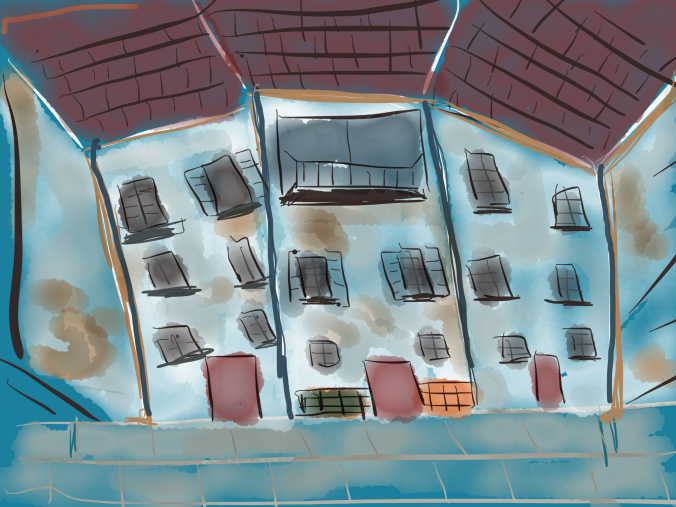 |
| “Cellar Window in the Courtyard” –illustration 2016 by jpbohannon |
J.P. BOHANNON
 The English translation of Elena Ferrante’s L’amica geniale has been given the title My Brilliant Friend and for much of the book we believe it to be a reference to Lila Cerullo, the daughter of the shoemaker and the much-admired friend of the narrator Elena Greco (known as Lenù). And indeed, the phrase fits, for Lila is a precociously wise, driven, and independently thinking little girl. (The novel spans the two girls’ lives from six to sixteen.) And yet, much later in the book, when Lila is being fitted for a wedding dress, it is she who utters the phrase, calling the quieter, less assured Lenù “my brilliant friend.” Much to Lenù’s delight.
The English translation of Elena Ferrante’s L’amica geniale has been given the title My Brilliant Friend and for much of the book we believe it to be a reference to Lila Cerullo, the daughter of the shoemaker and the much-admired friend of the narrator Elena Greco (known as Lenù). And indeed, the phrase fits, for Lila is a precociously wise, driven, and independently thinking little girl. (The novel spans the two girls’ lives from six to sixteen.) And yet, much later in the book, when Lila is being fitted for a wedding dress, it is she who utters the phrase, calling the quieter, less assured Lenù “my brilliant friend.” Much to Lenù’s delight. But close readers come to understand this much earlier in the novel. Through the first two-thirds of the book we are caught up in Lenù’s appreciation, competition, and admiration of her friend Lila. Lenù is telling the story of HER BRILLIANT FRIEND. But gradually we realize that the novel is actually the story of Lenù, the story of her friendship with Lila, and the decisions the SHE ultimately makes not to be dragged down into the social stagnation that is their poor Neapolitan neighborhood. (Lenù is telling us this story as a 60-year old woman living in Turin after Lila’s son has called from Naples to say his mother has disappeared.)
But close readers come to understand this much earlier in the novel. Through the first two-thirds of the book we are caught up in Lenù’s appreciation, competition, and admiration of her friend Lila. Lenù is telling the story of HER BRILLIANT FRIEND. But gradually we realize that the novel is actually the story of Lenù, the story of her friendship with Lila, and the decisions the SHE ultimately makes not to be dragged down into the social stagnation that is their poor Neapolitan neighborhood. (Lenù is telling us this story as a 60-year old woman living in Turin after Lila’s son has called from Naples to say his mother has disappeared.)
That Lila is brilliant there is no doubt. She excels in grade school–always edging out her friend Lenù and everyone else–and wins the admiration of all the teachers. She is fierce and brave and sure of herself. Meanwhile, Lenù is like most every youngster, tentative, unsure of herself, and uncomfortable in her ever-changing body. Even after Lila has quit schooling at the age of twelve, she continues to learn and tutors Lenù in Latin and in Greek and sharpens Lenu’s mind with logic and politics and philosophy.
And while Lila finally succumbs to the fate circumscribed by the neighborhood courtyard, Lenù knows that her schooling–an “occupation’ that none of her neighbors or friends or family see the value of–is her only way to break beyond the poverty, the dirt, the violence.
And by this point we see that the novel is Lenù’s Icarus moment, her attempt to fly, to soar higher than those before her. We leave her “on the cliff’s edge,” as she begins to realize at Lila’s wedding the cords that the neighborhood could tie her down with. We readers had also hoped that her friend Lila would join her, but she cannot. At least for now.
Elena Ferrante may be the most written about novelist of the past five years. She is reviewed in the mainstream press and in literary journals. She is both critically and popularly acclaimed. And she is “anonymous”–no one knows her true identity. (Despite a mid-March break through, that cited a Florentine history professor who has denied that she is Ferrante.) This mystery certainly has added to her cachet. And has added to the millions of words written about her.
And yet, even if there were no “mystery,” Ferrante would stand out. Her writing is more than masterful–the narrative is a driving, relentless tour of childhood, filled with incisive details–both external and internal–and a realistic understanding of human fears, desires, needs and ambitions. My Brilliant Friend–the first of Ferrante’s four Neapolitan novels–follows the girls from six to sixteen, and captures exquisitely and perfectly, the pain and joy and dread and hopes of young children in a way that is unmatched in my reading.
Yet, like life itself when looking backwards, those ten years that Ferrante chronicles seem to fly by and are finished before we know it…or are ready for it.
I facetiously wrote to a friend that I found My Brilliant Friend “disappointing”: my great disappointment was that the 330-page novel was over so quickly. I wanted it not to end.
I will take a breather…and then begin the second volume.





No comments:
Post a Comment